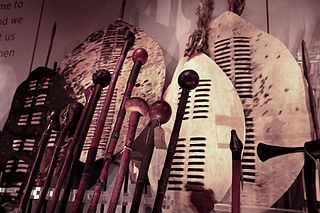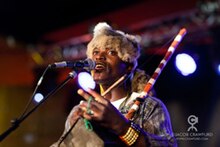SothoSesotho, also known as Southern Sotho or Sesotho sa Borwa is a Southern Bantu language of the Sotho–Tswana ("S.30") group, spoken in Lesotho, and South Africa where it is an official language;

The Sotho, also known as the Basotho, are a prominent Sotho-Tswana ethnic group with roots in Southern Africa. They primarily inhabit the regions of Lesotho and South Africa.

Moshoeshoe I was the first king of Lesotho. He was the first son of Mokhachane, a minor chief of the Bamokoteli lineage, a branch of the Koena (crocodile) clan. In his youth, he helped his father gain power over some other smaller clans. At the age of 34 Moshoeshoe formed his own clan and became a chief. He and his followers settled at the Butha-Buthe Mountain. He became the first and longest-serving King of Lesotho in 1822.
Thomas Mokopu Mofolo is considered the greatest Basotho author. He wrote mostly in the Sesotho language, but his most popular book, Chaka, has been translated into English and other languages.

Lesotho is a Southern African nation surrounded entirely by South Africa. The largest ethnic group is the Basotho. The Basotho culture is immersed in musical traditions.

A knobkerrie, also spelled knobkerry, knobkierie, and knopkierie (Afrikaans), is a form of wooden club, used mainly in Southern Africa and Eastern Africa. Typically they have a large knob at one end and can be used for throwing at animals in hunting or for clubbing an enemy's head. For the various peoples who use them, they often have marked cultural significance. Being able to carry the knobkerrie has also had a political dimension, especially in South Africa.

The Sotho-Tswana, also known as the Sotho or Basotho, although the term is now closely associated with the Southern Sotho peoples are a meta-ethnicity of Southern Africa. They are a large and diverse group of people who speak Sotho-Tswana languages. The group is predominantly found in Botswana, Lesotho, South Africa, and the western part of Zambia. Smaller groups can also be found in Namibia and Zimbabwe.
Thekiso in the Sotho–Tswana languages, is the name of clan or family.
The orthography of the Sotho language is fairly recent and is based on the Latin script, but, like most languages written using the Latin alphabet, it does not use all the letters; as well, several digraphs and trigraphs are used to represent single sounds.

Christianity is the dominant religion in Lesotho, with Protestantism and Catholicism being its main denominations.
Famo is a type of music from Lesotho in Africa consisting of singing accompanied by the accordion, a drum and occasionally a bass. It originated in the drinking dens of migrant workers from Lesotho trying to relax after working in the mines in the 1920s but is now a popular form of music for Sesotho speakers.
Ga-Molepo is a town in Capricorn District Municipality and Polokwane Local Municipality in the Limpopo province of South Africa.
The Bobirwa Subdistrict is a jurisdiction in Botswana. It is populated by the Babirwa (Ba-Birwa) people who came from Transvaal in present-day South Africa.

Litema, spelled as Ditema in South African Sesotho orthography is a form of Sesotho mural art composed of decorative and symbolic geometric patterns, commonly associated with Sesotho tradition today practised in Lesotho and neighbouring areas of South Africa. Basotho women generate litema on the outer walls and inside of homesteads by means of engraving, painting, relief mouldings and/or mosaic. Typically the geometric patterns are combed or scratched into the wet top layer of fresh clay and dung plaster of the wall, and later painted with earth ochers or, in contemporary times, manufactured paint. Patterns most often mimic ploughed fields through a combed texture, or the patterns refer to plant life, and more occasionally to other aspects of the natural world, such as referring to clan totem animal. Litema are transient; they may desiccate and crumble or be washed away by heavy rain. It is common for women of an entire village to apply litema on such special occasions as a wedding or a religious ceremony.

A mokorotlo is a type of straw hat widely used for traditional Sotho clothing, and is the national symbol of Lesotho and the national symbol of the Basotho and Lesotho peoples. An image of the Mokorotlo appears on the Lesotho flag, and on Lesotho vehicle license plates. The design is believed to have been inspired by the conical mountain Mount Qiloane. It is known as “molianyeoe”, which means "he who executes judgement in court" in Sesotho. It is manufactured from an indigenous grass known as “mosea” or “leholi”.
Motsoalle is the term for socially acceptable, long-term relationships between Basotho women in Lesotho. Motsoalle can be translated from Sesotho loosely as "a very special friend." The word, motsoalle, is used to describe the other woman, as in "she is my motsoalle;" and a motsoalle relationship describes the bond between the two women. Motsoalle relationships are socially sanctioned and have often been celebrated by the people of Lesotho. These women's relationships usually occur alongside otherwise conventional heterosexual marriages and may involve various levels of physical intimacy between the female partners. Motsoalle relationships have, over time, begun to disappear in Lesotho.
Ntšeliseng ’Masechele Khaketla was a pioneering poet, dramatist, translator, and teacher from Lesotho.

Joshua Pulumo Mohapeloa (1908-1982) was a prominent choral music composer in Sesotho, the native language of the BaSotho people of Southern Africa.
Daniel Pule Kunene (1923-2016) was a South African literary scholar, translator and writer. He was Emeritus Professor of African Languages and Literature at the University of Wisconsin-Madison.










